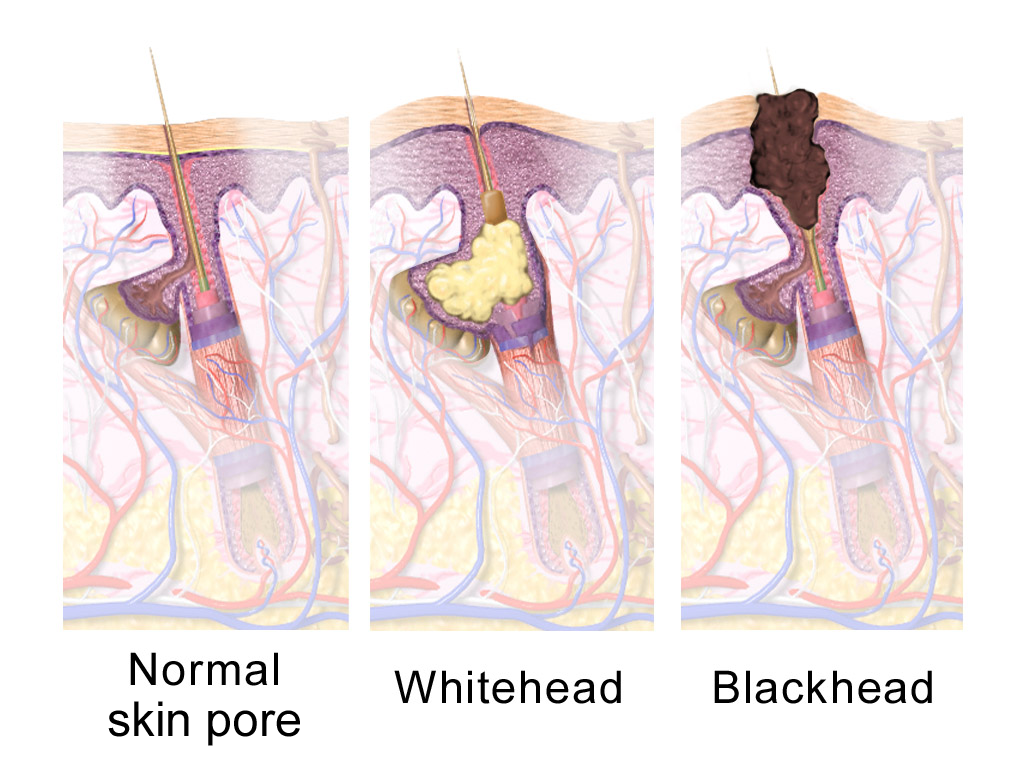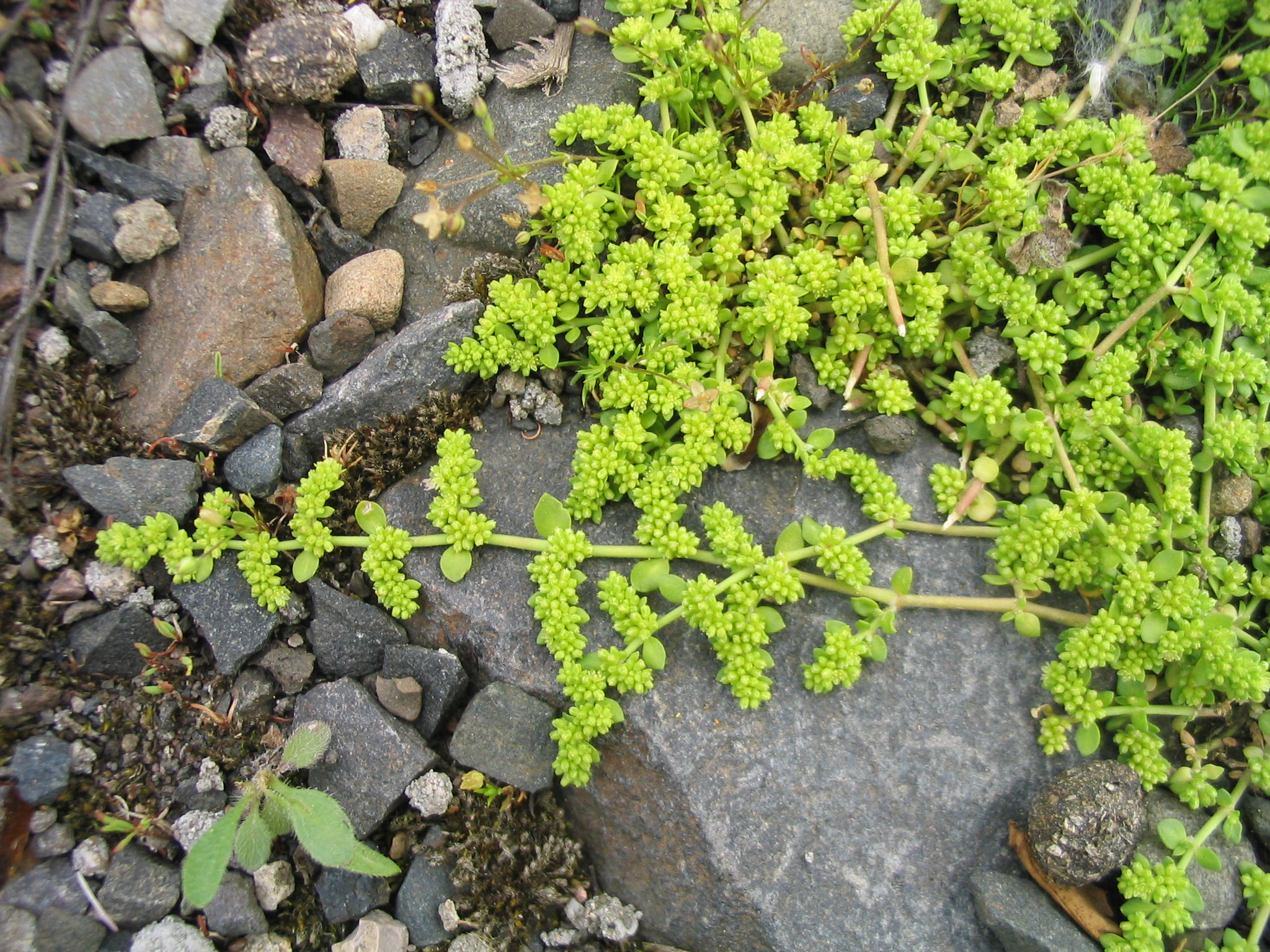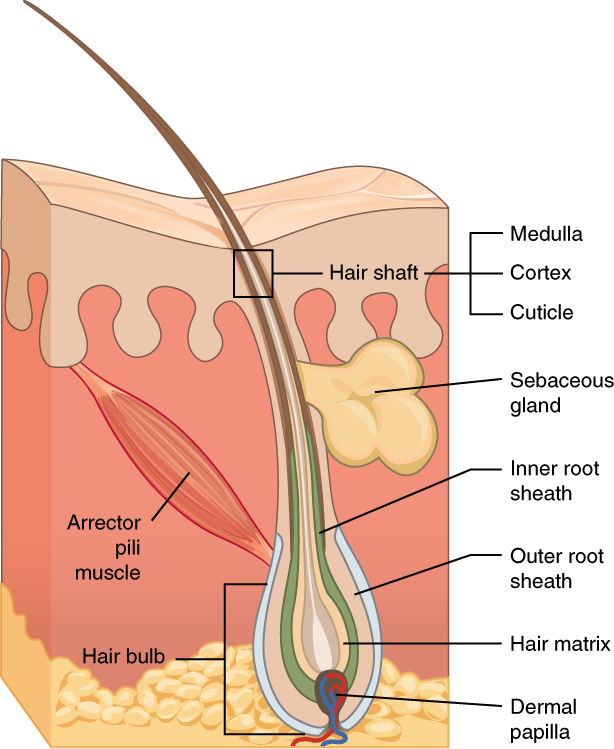|
Sebaceous Gland
A sebaceous gland or oil gland is a microscopic exocrine gland in the skin that opens into a hair follicle to secrete an oily or waxy matter, called sebum, which lubricates the hair and skin of mammals. In humans, sebaceous glands occur in the greatest number on the face and scalp, but also on all parts of the skin except the palms of the hands and soles of the feet. In the eyelids, meibomian glands, also called tarsal glands, are a type of sebaceous gland that secrete a special type of sebum into tears. Surrounding the female nipples, areolar glands are specialized sebaceous glands for lubricating the nipples. Fordyce spots are benign, visible, sebaceous glands found usually on the lips, gums and inner cheeks, and genitals. Structure Location In humans, sebaceous glands are found throughout all areas of the skin, except the palms of the hands and soles of the feet. There are two types of sebaceous glands: those connected to hair follicles and those that ex ... [...More Info...] [...Related Items...] OR: [Wikipedia] [Google] [Baidu] |
Arrector Pili Muscle
The arrector pili muscles, also known as hair erector muscles, are small muscles attached to hair follicles in mammals. Contraction of these muscles causes the hairs to stand on end, known colloquially as goose bumps (piloerection). Structure Each arrector pili is composed of a bundle of smooth muscle fibres which attach to several follicles (a follicular unit). Each is innervated by the sympathetic division of the autonomic nervous system. The muscle attaches to the follicular stem cell niche in the follicular bulge, splitting at their deep end to encircle the follicle. Function The contraction of the muscle is involuntary. Stresses such as cold, fear etc. may stimulate the sympathetic nervous system, and thus cause muscle contraction. Thermal insulation Contraction of arrector pili muscles have a principal function in the majority of mammals of providing thermal insulation. Air becomes trapped between the erect hairs, helping the animal retain heat. Self defence Many ... [...More Info...] [...Related Items...] OR: [Wikipedia] [Google] [Baidu] |
Preening
Preening is a found in birds that involves the use of the beak to position feathers, interlock feather that have become separated, clean plumage, and keep ectoparasites in check. Feathers contribute significantly to a bird's insulation, waterproofing and aerodynamic flight, and so are vital to its survival. Because of this, birds spend considerable time each day maintaining their feathers, primarily through preening. Several actions make up preening behaviour. Birds fluff up and shake their feathers, which helps to "rezip" feather barbules that have become unhooked. Using their beaks, they gather preen oil from a gland at the base of their tail and distribute this oil through their feathers. They draw each contour feather through their bill, nibbling it from base to tip. Over time, some elements of preening have evolved to have secondary functions. Ritualised preening has become a part of some courtship displays, for example. It is also a displacement activity that can occu ... [...More Info...] [...Related Items...] OR: [Wikipedia] [Google] [Baidu] |
Areolar Gland
Areolar glands, also known as glandulae areolares, Montgomery glands, and tubercula areolae, are 10-15 elevations found on the areola. They are usually arranged in a circle around the nipple, and can be particularly visible when the nipple is erect. Their role is to promote adequate breastfeeding of the infant. They are sebaceous glands, which secrete sebum oil that is a free fatty acid onto the skin that lubricates the nipple when breastfeeding, protects the skin, and provides some air tightness between the infant's mouth and the nipple. They also emit odor compounds into the air that attract babies. In addition, a study of 121 white mothers found that higher numbers of areolar glands on the breasts (commonly known as AG number) was correlated with infants gaining weight faster and lactation beginning faster. A meta-analysis shows that odor compounds emitted from lactating breasts reduced arousal states in active newborns, increases arousal states in sleepy newborns, and caus ... [...More Info...] [...Related Items...] OR: [Wikipedia] [Google] [Baidu] |
Labia Minora
The labia minora (Latin for 'smaller lips', : labium minus), also known as the inner labia, inner lips, or nymphae, are two flaps of skin that are part of the primate vulva, extending outwards from the inner Vagina#Vaginal opening and hymen, vaginal and Urethral meatus, urethral openings to encompass the Vulval vestibule, vestibule. At the glans clitoridis, each labium splits, above forming the clitoral hood, and below the frenulum of the clitoris. At the bottom, the labia meet at the ''labial commissure''. The labia minora vary widely in size, color and shape from individual to individual. The labia minora are situated between the labia majora and together form the labia. The labia minora are Homology (biology), homologous to the penile raphe and ventral penile skin in males. Structure and functioning The labia minora extend from the clitoris obliquely downward, laterally, and backward on either side of the vulval vestibule, ending between the bottom of the vulval vestibule and ... [...More Info...] [...Related Items...] OR: [Wikipedia] [Google] [Baidu] |
Penis
A penis (; : penises or penes) is a sex organ through which male and hermaphrodite animals expel semen during copulation (zoology), copulation, and through which male placental mammals and marsupials also Urination, urinate. The term ''penis'' applies to many intromittent organs of vertebrates and invertebrates, but not to all. As an example, the intromittent organ of most Cephalopoda is the hectocotylus, a specialized arm, and male spiders use their pedipalps. Even within the Vertebrata, there are morphological variants with specific terminology, such as Hemipenis, hemipenes. Etymology The word "penis" is taken from the Latin word for "Latin profanity#Synonyms and metaphors, tail". Some derive that from Proto-Indo-European language, Indo-European ''*pesnis'', and the Greek word πέος = "penis" from Indo-European ''*pesos''. Prior to the adoption of the Latin word in English, the penis was referred to as a "yard". The Oxford English Dictionary cites an example of the w ... [...More Info...] [...Related Items...] OR: [Wikipedia] [Google] [Baidu] |
Human Nose
The human nose is the first organ of the respiratory system. It is also the principal organ in the olfactory system. The shape of the nose is determined by the nasal bones and the nasal cartilages, including the nasal septum, which separates the nostrils and divides the nasal cavity into two. The nose has an important function in breathing. The nasal mucosa lining the nasal cavity and the paranasal sinuses carries out the necessary conditioning of inhaled air by warming and moistening it. Nasal conchae, shell-like bones in the walls of the cavities, play a major part in this process. Filtering of the air by nasal hair in the nostrils prevents large particles from entering the lungs. Sneezing is a reflex to expel unwanted particles from the nose that irritate the mucosal lining. Sneezing can Transmission (medicine), transmit infections, because aerosols are created in which the Respiratory droplets, droplets can harbour pathogens. Another major function of the nose is olfactio ... [...More Info...] [...Related Items...] OR: [Wikipedia] [Google] [Baidu] |
Glabrous Skin
Glabrousness () is the technical term for a lack of hair, down hair, down, setae, trichomes, or other such covering. A glabrous surface may be a natural characteristic of all or part of a plant or animal, or be due to loss because of a physical condition, such as alopecia universalis in humans, which causes hair to fall out or not regrow. In botany Glabrousness or otherwise, of leaves, stems, and fruit is a feature commonly mentioned in plant Identification key, keys; in botany and mycology, a ''glabrous'' morphology (biology), morphological feature is one that is smooth and may be glossy. It has no bristles or hair-like structures such as trichomes. In anything like the zoological sense, no plants or fungi have hair or wool, although some structures may resemble such materials. The term "glabrous" strictly applies only to features that lack trichomes at all times. When an organ bears trichomes at first, but loses them with age, the term used is ''glabrescent''. In the model p ... [...More Info...] [...Related Items...] OR: [Wikipedia] [Google] [Baidu] |
Hair Shaft
Hair is a protein filament that grows from follicles found in the dermis. Hair is one of the defining characteristics of mammals. The human body, apart from areas of glabrous skin, is covered in follicles which produce thick terminal and fine vellus hair. Most common interest in hair is focused on hair growth, hair types, and hair care, but hair is also an important biomaterial primarily composed of protein, notably alpha-keratin. Attitudes towards different forms of hair, such as hairstyles and hair removal, vary widely across different cultures and historical periods, but it is often used to indicate a person's personal beliefs or social position, such as their age, gender, or religion. Overview Meaning The word "hair" usually refers to two distinct structures: #the part beneath the skin, called the hair follicle, or, when pulled from the skin, the bulb or root. This organ is located in the dermis and maintains stem cells, which not only re-grow the hair after it falls o ... [...More Info...] [...Related Items...] OR: [Wikipedia] [Google] [Baidu] |
Acinus
An acinus (; : acini; adjective, acinar or acinous) refers to any cluster of cells that resembles a many-lobed "berry", such as a raspberry ('' acinus'' is Latin for "berry"). The berry-shaped termination of an exocrine gland, where the secretion is produced, is acinar in form, as is the alveolar sac containing multiple alveoli in the lungs. Exocrine glands Acinar exocrine glands are found in many organs, including: * the stomach * the sebaceous gland of the scalp * the salivary glands of the tongue * the liver * the lacrimal glands * the mammary glands * the pancreas * the bulbourethral (Cowper's) glands The thyroid follicles can also be considered of acinar formation but in this case the follicles, being part of an ''endocrine'' gland, act as a hormonal deposit rather than to facilitate secretion. Mucous acini usually stain pale, while serous acini usually stain dark. Lungs The end of the terminal bronchioles in the lungs The lungs are the primary organs of ... [...More Info...] [...Related Items...] OR: [Wikipedia] [Google] [Baidu] |
Hair Follicles
The hair follicle is an organ found in mammalian skin. It resides in the dermal layer of the skin and is made up of 20 different cell types, each with distinct functions. The hair follicle regulates hair growth via a complex interaction between hormones, neuropeptides, and immune cells. This complex interaction induces the hair follicle to produce different types of hair as seen on different parts of the body. For example, terminal hairs grow on the scalp and lanugo hairs are seen covering the bodies of fetuses in the uterus and in some newborn babies. The process of hair growth occurs in distinct sequential stages: ''anagen'' is the active growth phase, ''catagen'' is the regression of the hair follicle phase, ''telogen'' is the resting stage, ''exogen'' is the active shedding of hair phase and ''kenogen'' is the phase between the empty hair follicle and the growth of new hair. The function of hair in humans has long been a subject of interest and continues to be an important top ... [...More Info...] [...Related Items...] OR: [Wikipedia] [Google] [Baidu] |
Foot
The foot (: feet) is an anatomical structure found in many vertebrates. It is the terminal portion of a limb which bears weight and allows locomotion. In many animals with feet, the foot is an organ at the terminal part of the leg made up of one or more segments or bones, generally including claws and/or nails. Etymology The word "foot", in the sense of meaning the "terminal part of the leg of a vertebrate animal" comes from Old English ''fot'', from Proto-Germanic *''fot'' (source also of Old Frisian ''fot'', Old Saxon ''fot'', Old Norse ''fotr'', Danish ''fod'', Swedish ''fot'', Dutch ''voet'', Old High German ''fuoz'', German ''Fuß'', Gothic ''fotus'', all meaning "foot"), from PIE root *''ped-'' "foot". The plural form ''feet'' is an instance of i-mutation. Structure The human foot is a strong and complex mechanical structure containing 26 bones, 33 joints (20 of which are actively articulated), and more than a hundred muscles, tendons, and ligaments.Podiatry Chan ... [...More Info...] [...Related Items...] OR: [Wikipedia] [Google] [Baidu] |
Sex Organ
A sex organ, also known as a reproductive organ, is a part of an organism that is involved in sexual reproduction. Sex organs constitute the primary sex characteristics of an organism. Sex organs are responsible for producing and transporting gametes, as well as facilitating fertilization and supporting the development and birth of offspring. Sex organs are found in many species of animals and plants, with their features varying depending on the species. Sex organs are typically differentiated into male and female types. In animals (including humans), the male sex organs include the testicles, epididymis, epididymides, and penis; the female sex organs include the clitoris, Ovary, ovaries, oviducts, and vagina. The testicle in the male and the ovary in the female are called the ''primary sex organs''. All other sex-related organs are known as ''secondary sex organs''. The outer parts are known as the genitals or external genitalia, visible at birth in both sexes, while the in ... [...More Info...] [...Related Items...] OR: [Wikipedia] [Google] [Baidu] |








